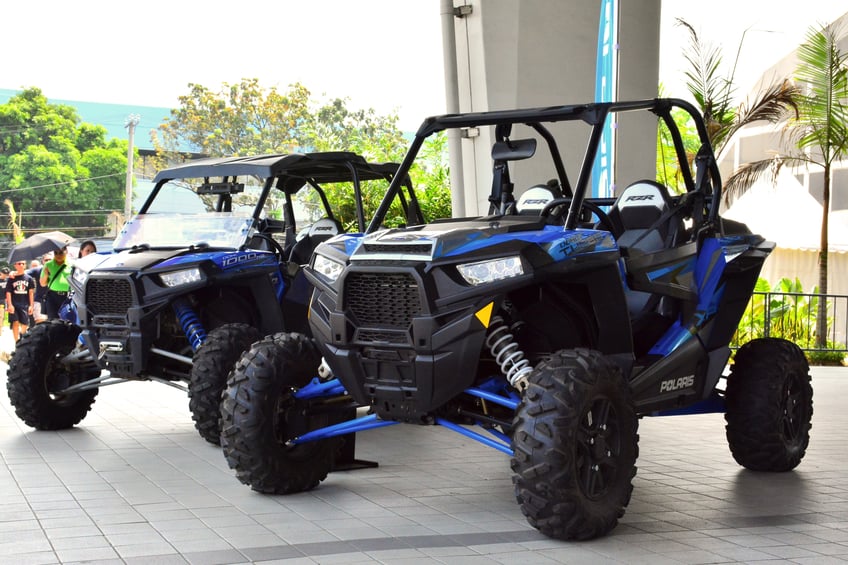The Australian Competition and Consumer Commission (ACCC) released a report and new regulations on ATV manufacturers last year through their Quadbike Taskforce, called the Consumer Goods (Quad Bikes) Safety Standard 2019. Their report found quadbikes (AKA ATVs) were inherently unstable, causing 15 deaths and 650 hospitalisations yearly. Their research informed legislation recommendations to force manufacturers to build utility ATVs with more safety features than before.
Hire ATVs Australia-wide
Honda, Yamaha, Suzuki and Polaris are the four biggest ATV brands in Australia, and all of them have stated their intention to pull their stock instead of building models that comply with the new regulations.
As the first stage of enforcing these regulations begins this month and Polaris officially pulls their stock from the Australian market, we investigate why all this is happening.
What does the legislation require ATV brands to do?
The Consumer Goods (Quad Bikes) Safety Standard 2019 is being enforced in two stages.
Stage 1, being implemented this month, requires utility ATVs to attach a rollover warning advising operators to avoid sudden sharp turns even on flat terrain, and avoid steep inclines and riding across slopes altogether. ATVs must be tested for their lateral stability based on ACCC test guidelines, and companies have to attach a lateral roll stability tag to the bike that records the minimum angle the ATV tipped sideways onto 2 wheels in testing.
All four of the ATV brands pulling their stock from Australia – Honda, Yamaha, Suzuki and Polaris – meet or can meet these standards. Honda, Yamaha and Suzuki are continuing to export ATVs to Australia under Stage 1, but Polaris has already stopped.
Stage 2, to be implemented in October 2021, requires manufacturers to build ATVs with Operator Protection Devices (OPDs) and meet minimum lateral roll, forward pitch and rearward pitch requirements. To meet the lateral roll, forward pitch and rearward pitch requirements, manufacturers are recommended to widen the wheelbases of their vehicles.
OPDs usually come as a hairpin-shaped bar or flexible arc mounted to the back of the vehicle. The OPDs ATV brands must use include: ATV Lifeguard by Ag-Tech Industries Ltd, or; Quadbar by QB Industries Pty Ltd, or; a device that offers the same or better level of operator protection from rollover.
Honda, Yamaha, Suzuki and Polaris all claim it is unfeasible to comply with Stage 2 regulations.
Why are ATV brands refusing to comply?

ATV manufacturers say it’s not worth designing and manufacturing new models with extra safety features for one country (the only other nation that’s introduced these regulations is Israel) with the demand for ATVs dropping. They also cite research that finds no evidence of the required safety features working. Yamaha in particular accuses the ACCC of implementing the law for political reasons, not scientific ones.
Statements from Polaris and Suzuki say they think the Stage 2 required changes to ATVs will introduce as many safety risks as they solve, Suzuki using research from the US vehicle safety research firm Dynamic Research Inc., which finds the risk of injury is greater than the injury prevention for Quadbar, one of the OPDs recommended by the ACCC.
Yamaha claims the OPDs required by the new regulations are untested, citing 3 coronial enquiries suggesting behavioural changes are better solutions to ATV-related injuries and deaths than product modification.
The ACCC agrees that better operator training and education, helmet wearing and banning under 16-year-olds from using adult quad bikes would also improve safety, but insists that structural changes to the machines themselves need to be made.
Some farmhands report using ATVs with “roll bars” - a type of ROPS - experiencing difficulty avoiding accidents as the roll bars get caught on trees.
What’s the science behind the legislation?
The ACCC stands by the legislation, saying they’re confused why companies believe they have to pull stock.
The University of New South Wales published three case studies assessing the effectiveness of OPDs in preventing ATV rollover related injuries.
When a quad bike tour company implemented OPDs on their bikes, though the number of bikes in operation more than tripled, their number of incidents stayed the same, and the number of helicopter-requiring injuries were eliminated, their number of ambulance-requiring injuries were a tenth of before, their number of first-aid requiring injuries were a fifteenth of before, and their injuries caused by the ATV rolling onto the rider were eliminated.
A quadbike fleet managers’ survey found OPDs reduced rollover crashes almost fivefold, where an OPD prevented injury in 10 of 12 rollover cases. In these cases, the OPD most often stopped the ATV from rolling onto the rider, and sometimes held the ATV above the rider.
The effects we’re seeing already

Utility ATVs are seen as vital farm equipment for mustering on hilly and boggy conditions. Especially in regional areas, smaller dealerships are struggling to source ATVs as their stocklist only includes the biggest ATV brands, which are the ones taking their stock out. Other ATV brands such as CF Moto either already comply with the legislation or have stated their intentions to build compliant models, but dealers still expect to stop selling ATVs altogether. Because of this mentality, consumers are anticipating not being able to use ATVs on their farms at all. Many are buying multiple ATVs at a time and storing them for later.
Though Suzuki hasn’t yet stopped exporting utility ATVs to Australia, some regional dealerships have run out of their models completely.
Now what?
Polaris has already withdrawn their ATVs from Australia, while Suzuki, Honda and Yamaha are still supplying stock compliant with Stage 1 regulations until Stage 2 regulations take effect next year. CF Moto is one of the ATV brands that plan to comply with regulations and continue supplying stock to Australia even after October 2021.
Both Polaris and Yamaha sell side-by-side vehicles (SSVs) that don’t have to comply with the new regulations, expecting them to essentially replace ATVs. Polaris even advertised the ROPS on their SSVs after refusing to implement them on their quad bikes.
Yamaha also assured consumers they would continue to sell their agricultural (AG) bikes.
But farmers are concerned that SSVs aren’t manoeuvrable enough for farm conditions on tough terrain or in orchard settings and will get bogged in wet conditions.
The legislation does not pertain to sport and youth models, so Yamaha will continue to export them to Australia. Polaris will not.
Polaris and Yamaha have both stated their intention to continue providing customer support supplying and servicing parts after ceasing export of new machines and supply utility ATVs in other countries. The National Farmers Federation (NFF) assure consumers that in the only other country to introduce this legislation (Israel), even when ATV brands stopped exporting to their franchisees, the models were available through private retailers. They expect to see the same result in Australia.


